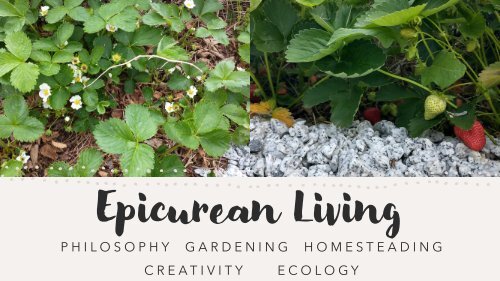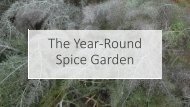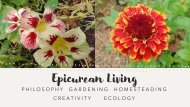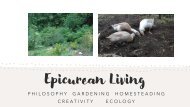Epicurean Living (Issue 4)
This is the natural gardening, change, and adapt issue!
This is the natural gardening, change, and adapt issue!
You also want an ePaper? Increase the reach of your titles
YUMPU automatically turns print PDFs into web optimized ePapers that Google loves.
<strong>Epicurean</strong> <strong>Living</strong><br />
P H I L O S O P H Y G A R D E N I N G H O M E S T E A D I N G<br />
C R E A T I V I T Y<br />
E C O L O G Y
Flowers can bear fruit. Those fruits can alter the<br />
evolutionary history of their species if they become plants.<br />
Yet not all flowers fruit and few fruits grow into plants.<br />
Does that make the rest of them failures?<br />
Everything<br />
Matters!<br />
Those masses of flowers attracted the pollinators and<br />
provided the pollen that made fruit possible. The genetic<br />
coding carried in a grain of pollen, from a flower that didn’t<br />
fruit, might lead to disease resistance or heat tolerance.<br />
Also don’t forget that those flowers and their pollen were<br />
only possible thanks to the tree that bore them, the<br />
community of soil life that nurtured the tree, and the air,<br />
water, climate, and sunlight that underpin all life on earth.<br />
Humans aren’t always good at appreciating the details<br />
and complexities of natural (or even human) processes. But<br />
with or without our recognition, everything on earth has<br />
significance, down to the smallest grain of pollen or unit of<br />
ordinary matter (an atom).
Every bloom is an expression of eons<br />
of evolution and countless,<br />
community contributions.
The challenges of the present, and what we’ve faced the<br />
past few years, weren’t localized. These issues have afflicted<br />
every culture and society on the planet.<br />
The massive scale of disruption to our global human<br />
systems has left many of us feeling rattled and afraid. Sadly, the<br />
problems to date are only the beginning of the unavoidable<br />
ecological challenges human activity has already set in motion.<br />
Finding<br />
Meaning<br />
In the face of these challenges, will we wallow in anger, live<br />
in misery, place blame on others, and allow negativity to<br />
devour us from within? Or will we find meaning by channeling<br />
our distress into effectively adapting, regenerating our natural<br />
world, being of service to each other, and creating an<br />
alternate, more loving trajectory than the one we are now on.<br />
This is the test of our humanity.
The <strong>Epicurean</strong> Garden
We live on a garden planet, floating in an otherwise<br />
uninhabitable corner of space. The food, water, and air we<br />
consume depend on complex interactions that impact us all.<br />
The Garden<br />
❖ Air circles the earth collecting and transporting essences (like<br />
California fire smoke visible against a New York City skyline.)<br />
❖ Air picks up evaporated water, full of particles (or pollutants),<br />
carries it hundreds to thousands of miles then drops it as rain.<br />
❖ Soil absorbs rain, delivers it to water tables and to waterways<br />
that humans, animals, plants, fish, and fungi rely on.<br />
❖ As we consume, our waste also enters that system becoming<br />
part of our air, soil, water, food, and surroundings.<br />
This connectedness is inescapable. Some call it the web of<br />
life. Whether we realize it or not, we are all tending this garden<br />
earth, every day, with every choice, and every action we take.<br />
What an incredibly empowering thought…<br />
Our actions do impact the entire world!
Garden Care
Natural Gardening<br />
We can garden in ways that require minimal maintenance<br />
and produce better yields, while improving the natural systems<br />
that underpin our lives on earth. This kind of gardening goes by<br />
names like natural gardening, permaculture, plant guilding,<br />
forest gardening, no till, biomimicry, wild gardening, and more.<br />
By using inter, under or companion planting, cover cropping,<br />
mulching, green manuring, composting and other natureinspired<br />
ideas you can fast-track soil improvement, increase<br />
water retention, and better support plant and wildlife health as<br />
you enjoy and harvest from your garden.<br />
The point of natural gardening isn’t to control nature or to<br />
let nature do all the work. Instead, we gain experience by<br />
studying nature. Then we use human ingenuity to engage those<br />
natural concepts in thoughtful ways to create the gardens of<br />
our dreams and heal the earth!
Use Biomimicry
Mimic Natural<br />
Biological<br />
Systems in the<br />
Garden<br />
Mimicking natural biological systems (biomimicry) is a<br />
beautiful way to make gardening easier. For example, in forests,<br />
nature grows plants in layers to maximize soil use, sunlight access,<br />
moisture retention, and support wildlife without creating resource<br />
scarcity or plant competition.<br />
❖ Tall trees have leaf shapes and branching habits that allow light<br />
to filter down to lower trees and shrubs.<br />
❖ Shorter trees, shrubs of various sizes, vines, and ground cover<br />
thrive together using different soil depths and root types to<br />
create a multi-layered story of textures, shape, and flowers.<br />
❖ These layers create habitat for insects, birds, reptiles, and<br />
mammals to co-exist by sharing resources, nourishing each<br />
other and the soil, while natural cycles regulate populations.<br />
You can replicate those ideas in your garden using good plant<br />
selection. Look at local, natural examples in your bioregion for<br />
inspiration. Then emulate nature using cultivated plants.
A key concept in natural gardening is to grow plants in guilds<br />
that mimic natural patterns. A guild, of plants or people, is a<br />
community that works together for a common purpose.<br />
Unite Purposeful<br />
Plant Guilds<br />
On the next page, chestnuts, maple, tulip poplar, pine, paw<br />
paws, elderberries, grapes, blackberries, lemon balm,<br />
peppermint, broadleaf plantain, curly dock, Carolina allspice,<br />
honeyberries, winecap mushrooms, and even ornamental<br />
hydrangeas cooperate to create a mostly self-growing simulated<br />
human-centric forest, called a food forest.<br />
Similarly, the pollinator guild shown on this page works on<br />
the natural principle of seasonal plant colonies. Blocks of single<br />
plant types, are sown together like a quilt to attract and support<br />
pollinators by making it easy for them to forage in one place.<br />
Each plant flowers, one after another, to ensure a continuous<br />
food supply and visual interest. When early season plants die,<br />
their leaf matter feeds soil and late season plants grow up to<br />
occupy the space and support wildlife.
Grow a Food Forest
Companion<br />
Planting<br />
A fun way learn how to build complex, purposeful guilds is to<br />
start with companion planting. The goal is to intentionally grow two<br />
plants together to support each other’s health needs.<br />
For example, in clay soil, chicory roots use abundant clay<br />
minerals and rain to grow taproots that break up compaction and<br />
improve drainage. Since lavender requires good drainage, it can<br />
be hard to grow in clay soil. However, when co-planted with<br />
chicory, the chicory helps moisture percolate deeper and so<br />
lavender roots dry out faster.<br />
Likewise, underplanting grape vines with oregano encourages<br />
deeper grape roots, moderates soil temperature and moisture,<br />
reduces weeds, and mitigates fungal pathogens. Oregano would<br />
outcompete shallow rooted plants. But it’s beneficial under<br />
pathogen prone plants with the capacity to root deeply.<br />
Do research, experiment, and then follow your instincts to find<br />
useful companion combinations for your garden. If they work well,<br />
try them in a new location to confirm effectiveness. If they don’t<br />
work, reason out what went wrong, then try another combination.
Try Hedgerows and<br />
Alley Cropping
Perennial Support<br />
Growing annuals between plots of perennials creates an<br />
environment that is healthier for both kinds of plants,<br />
increases potential yields, cuts down on gardening work, and<br />
creates safe havens for resident wildlife.<br />
❖ In crop fields, grow hedgerows between fields.<br />
❖ In small backyards, grow a multispecies perennial hedge<br />
around your fence area with annuals to the center.<br />
❖ As part of a food forest, grow annual beds in lanes between<br />
forest strips called alley cropping.<br />
To support plant health and soil life in these mixed-use<br />
areas, apply high carbon mulch like chipped or shredded<br />
wood and fallen leaves under perennials. Opt for long-aged<br />
compost or green under annual plants.
Consider Permaculture
Permaculture<br />
Gardening<br />
Bill Mollison and David Holmgren codified the idea of<br />
“Permaculture” as permanent culture. Permaculture, as they<br />
envisioned it, requires a philosophical shift of provisioning our<br />
human needs with deep regard for the health of all natural<br />
systems. It starts with a well-researched, comprehensive plan for<br />
implementation that is unique to your home. You can learn more<br />
at https://holmgren.com.au/.<br />
As a first step, consider creating a Permaculture garden. This is<br />
a “closed loop system” not dependent on continually buying<br />
things like seeds, fertilizer, livestock feed, fuel, or other items.<br />
Permaculture gardens utilize rainwater. They contain mostly<br />
perennial and self-sowing plants or plants you can easily<br />
propagate at home. They typically include forage-fed livestock<br />
for food and soil fertility. They run on a zero-waste principle<br />
wherein everything is composted or upcycled. They require<br />
good planning and intelligent work to establish. But then<br />
become low maintenance.
Natural Gardening is Beautiful!
Nature Inspired<br />
There’s a misconception that natural gardens must be<br />
disorderly in appearance. They must mostly follow natural<br />
principles such as no synthetic products, no herbicides or<br />
pesticides, adding organic matter to soil, and using diverse<br />
plantings. Yet, that still allows room for personalization.<br />
Planting areas will be more crowded and diverse. But you<br />
can play with color and leaf texture. Straight rows of<br />
monocrops are infrequent as they promote weeds and pests.<br />
However, organized planting in diamond patterns, blocks, and<br />
spirals are lovely and effective alternatives.<br />
Natural gardens, like any garden, should reflect your<br />
personal tastes. Include cozy seating areas, pretty pots,<br />
sculpture, arbors, orderly paths, or other creative or decorative<br />
items to make your natural garden appealing to you!
The <strong>Epicurean</strong><br />
Homestead
Homestead Reality<br />
People frequently pick up ingredients at the supermarket,<br />
cutting out months of time spent growing those ingredients. It’s<br />
even normal to buy pre-made foods to stage like homemade.<br />
Homesteading is the antithesis of that instant gratification<br />
lifestyle. Instead, you embrace the pleasure of spending 3<br />
months to grow fava beans, 5+ months for milk to make yogurt<br />
sauce, 7 months to raise pigs and cure bacon, and 14 months<br />
for a shiitake mushroom harvest from inoculated logs for the<br />
simple homestead dish shown here.<br />
Of course, you don’t really start dinner 14 months early. You<br />
grow or raise what you love, that’s also suitable for your<br />
conditions. Then, you decide what to cook based on what’s<br />
harvestable in the garden, stashed in the pantry, and that<br />
ideates from your imagination.<br />
Your past work of choosing, growing, caring, and preserving<br />
become your present inspiration.
Extend Your<br />
Gratification<br />
Many people think the opposite of instant gratification is<br />
delayed gratification. But that’s only if you do it wrong!<br />
❖Sowing seeds with care and attention is a relaxing act.<br />
❖Watering plants is a chance to commune with nature.<br />
❖Harvesting and using garden weeds makes weeding a<br />
pleasure.<br />
❖Harvesting is a sensual experience of color, aroma,<br />
texture, and sampling for readiness.<br />
❖Cooking is a loving act of self, family, and friend care.<br />
❖Eating is the culmination of months of joyful <strong>Epicurean</strong><br />
homesteading.<br />
Don’t delay gratification. Increase it<br />
exponentially by enjoying every moment!
The Multiplier Effect<br />
Another common misconception about<br />
homesteading is that it’s expensive. That<br />
shouldn’t be the case since the primary goal is<br />
to decrease dependence on bought goods.<br />
Smart, one-time investments will multiply in<br />
value with good care. One seed becomes thirty.<br />
Thirty seeds re-planted become 900. Several<br />
hens and a rooster provide meat and eggs for<br />
years. Fruit trees planted once can produce for<br />
decades.
Forego the Factory Approach<br />
Homesteading can be costly if your focus is factory<br />
production. Buying 50 broilers and fattening them under<br />
lights, in a brooder, on bagged feed then processing all at<br />
once can be cheaper than buying from the grocery store. But<br />
it requires equipment, start-up money, an exhausting<br />
slaughter day, and a big freezer!<br />
Letting your heritage breed, free-range laying hen hatch<br />
out a few chicks, requires only a little supplemental feed, and<br />
garden/kitchen scraps. You also need a good knife, a little<br />
skill, and few minutes of processing time before you cook.<br />
To become less dependent on money, focus on selfsustaining<br />
systems rather than the factory approach. Look to<br />
pre-industrial farming methods and nature for inspiration.
Avoid Hard Work!<br />
Whenever homesteading feels like hard work, that’s<br />
a perfect time to slow down, solve problems, and<br />
revise routines to make it more enjoyable. A cup of a<br />
tea, time outdoors, and a good journal session can<br />
reveal the reasons why work feels hard.<br />
Have you set unreasonable deadlines? Is your back,<br />
rather than your brain, doing the heavy lifting? Can you<br />
break tasks down, extend them over time, and make<br />
them more manageable? Did you take a wrong path?<br />
Homesteading takes work, but it doesn’t have to be hard.
Some homesteading paths are less costly than others.<br />
Start Simple<br />
❖ Pressure canning requires a canner, a heat source, precise<br />
recipes, special ingredients, and jars. Fermenting only requires<br />
salt or sugar and containers you already have.<br />
❖ Aged cheese needs freeze-dried cultures and an aging cave.<br />
Fresh cheese requires only rennet or vinegar.<br />
❖ Traditional gardening requires fertilizer, herbicides, pesticides,<br />
and reduces harvests as soil life and health declines. Organic<br />
gardening improves soil and increases harvests over time<br />
using compost you make from free resources.<br />
❖ Fast-germinating, short season annual crops can be directsown<br />
in the garden. Long season/hard to start crops require<br />
pots, indoor lighting, heat, and hardening off before<br />
transplanting.<br />
You can do it all of these if you want to. But to save money<br />
now, start simple and invest your savings in the tasks you enjoy.
<strong>Epicurean</strong> Creativity
The<br />
Writing<br />
Life<br />
Once upon a time, I sat in an office dreaming about living the<br />
writing life. Now I am writing a novel about a character stifled by<br />
her office life who finds her way into a parallel world that runs on<br />
natural concepts.<br />
I am drawing from my experience of feeling stifled in the<br />
office and now living in more natural ways. Plus, I’m researching<br />
ideas I don’t know and seeking experiences I haven’t had as part<br />
of the creative process.<br />
Writing starts with what we know and then takes us deeper<br />
into topics we want to learn about. It’s an excuse to try things,<br />
engage with new people, and escape the extreme limitations of<br />
personal experience.<br />
You don’t have to be a writer to benefit from the writing life.<br />
Take what you know, engage with a new experience, and<br />
imagine the parts you don’t know to expand your appreciation<br />
and deepen your relationship with topics of interest.
Write about…<br />
❖ What life would be like if you didn’t have to follow the clock or<br />
rush to meet meaningless deadlines<br />
❖ How you’d live if all life’s resources were free like sunlight<br />
❖ What life would be like you if you eliminated the things about<br />
your current life that seem silly and extraneous and wasteful<br />
❖ What you’d do if you were transported to a different culture<br />
with different language<br />
❖ How beautiful your surroundings would be if you could create<br />
your own world<br />
Write ways to make your<br />
dreams come true!
Story Telling<br />
Culture is a matter of subjective storytelling. In the US, we<br />
tell ourselves the Constitution is the basis for deciding the<br />
validity of new laws. But the constitution was created by now<br />
dead, fault-filled humans, in a time when today’s technology<br />
was unimaginable. The Constitution only matters now because<br />
we still collectively choose to believe that story.<br />
The American dream of a college education, a stable job<br />
where you work hard so you can buy a house, cars, furniture,<br />
and save for retirement is another example. There’s no natural<br />
reason for us to live like that. But so many people believe that<br />
story, it’s treated as normal while natural living is abnormal.<br />
Some of the stories we believe limit our life choices and<br />
make it hard to adapt to the changes happening today.<br />
Sometimes we need to create and believe in new stories to<br />
effectively engage our present reality.<br />
Do your stories need updating?
The Creative Well<br />
When you are tapped into the creative well -- words,<br />
images, ideas, and other forms creative expression<br />
bubble up inside you and overflow into art, stories,<br />
gardens, design plans, and more. Creativity flows out into<br />
all areas of your life transforming mundane experiences<br />
into celebrations.<br />
The creative well is abundant and available to anyone<br />
who wants to tap in. But it’s not an app you turn on and<br />
off. It’s a force you attract by taking risks.<br />
Some of your early attempts at creation may be<br />
complete and embarrassing disasters. Do it any way<br />
because trying and failing is the price of admission to<br />
develop a direct connection to the creative well.
<strong>Epicurean</strong> Ecology
We often talk about earth as a planet with finite resources.<br />
But that’s not entirely true. Rays from the sun are continually<br />
shining new resources, in the form of light energy, into our<br />
atmosphere.<br />
Plants and other organisms use that sunlight plus finite<br />
resources from soil, water, air, and non-organic material to<br />
produce simple sugars. Those sugars then feed life forms<br />
that feed other life forms up and down the food chain.<br />
Every “renewable resource” on earth depends on the<br />
combing of sunlight and finite resources from inside our<br />
atmosphere. All life is fed by sunlight that’s beamed in every<br />
second of every day from 93 million miles away.<br />
Free Cycling<br />
Amazingly, the sun never receives a dollar of payment<br />
from the earth for all that energy or the products made using<br />
it. It’s the gift that keeps on giving.
Life is Change<br />
Life is change. From the moment a living thing begins to<br />
when it ends, it alters and is altered by its environment. On<br />
the scale of planetary time, the lifespan of every living thing<br />
is incredibly short. Our entire human history is just over a<br />
minute on a 12-hour clock. A single lifespan is smaller than<br />
an eyelash (or the largest known bacterium) on that scale.<br />
To imagine that life is static, that things should stay the<br />
same, to be wary or unwilling to embrace change is to deny<br />
the truth of our entire planetary history and the history of<br />
the innumerable lives lived before now.<br />
The one fundamental truth in all of nature is that to live is<br />
to change and be changed. We can change in chosen and<br />
meaningful ways or be changed by the life that happens to<br />
us. What we can’t do, is be unchanged and continue to live.
Embrace Change: Learn,<br />
Adapt, Improve, Grow, Give,<br />
Love, Live with Purpose
In nature, when food is abundant species increase their<br />
populations. During periods of scarcity, species depopulate<br />
with fewer births, shorter lifespans, or migration. Alternatively,<br />
species alter diets and living habits to use different resources.<br />
These cycles of scarcity amount to a self-regulating system<br />
that ensure the survival of the greatest number of species.<br />
Also, in the long-run thanks to free inputs of resources like<br />
sunlight, natural systems tend toward abundance overall.<br />
By contrast, after WWII, humans embraced the new idea<br />
that we must alter the environment to support increased<br />
population growth rates and enable ways of living that aren’t<br />
naturally sustainable.<br />
Abundance<br />
and Scarcity<br />
Ecologically speaking, that choice hasn’t created long-term<br />
abundance. It’s led to rapid declines in resources, human<br />
crowding, constant scarcity and struggle for most species<br />
including humans, enormous loss of natural diversity and<br />
massive human caused climate change.<br />
Is it time to consider alternative modes of living?
Humans have an estimated 6000+ thoughts per day. But how<br />
many of those are repetitive? How many are meaningful? How<br />
many are formed in response to things happening all around?<br />
How many are original, practical, aspirational, harmful, or ugly?<br />
Having more thoughts doesn’t make a person smarter or<br />
happier. It usually means they are easily distracted, unable to<br />
sustain a single idea, focused on repetitive negative thoughts,<br />
and highly influenced by other people or situations.<br />
Intentionally sustaining important and complex thoughts over<br />
a long period of time can alter brain chemistry and increase<br />
intelligence in ways that random thoughts simply can’t.<br />
Ecological Thinking<br />
Focusing on a complex, but automated task (like breathing or<br />
the germination of a seed) requires too much focus for many<br />
modern humans. But if you can quiet your mind and stay<br />
focused on one thought line, without succumbing to distractions,<br />
you will begin to understand nature.
Life is Short.<br />
Make it Meaningful!
Want More <strong>Epicurean</strong> Ideas?<br />
• Check out my books!<br />
• Visit me at Simplestead.com.<br />
• Follow me on Instagram<br />
@exploresimplestead.








